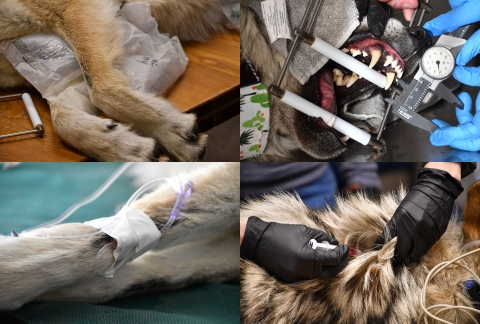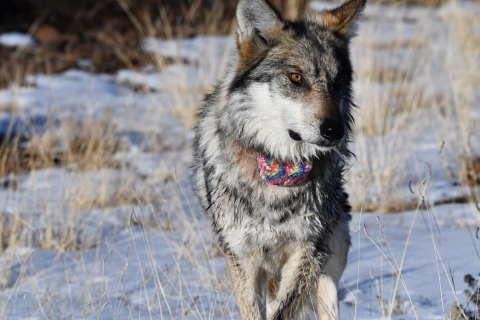Capturing wolves is a key component of the Mexican Wolf Recovery Program, helping with monitoring wolf movement, reproduction, and recovery in the wild. To better understand how capturing aids recovery, it’s helpful to understand how wolves are captured and everything that happens before they are released back into the wild.
The first step, before capturing can begin, is to prioritize which wolves need to be captured in the first place. For Mexican wolves, the program tries to maintain at least two radio collars per pack, so priorities are wolf packs or individuals without any radio tracking collars, followed closely by wolves with failing collars – in particular, breeding adult wolves. In addition, capturing wolves that were fostered into the wild from captivity remains a top priority year after year.
Two Methods for Capture
The U.S. Fish and Wildlife Service and its partners use two primary methods for capturing Mexican wolves: trapping on the ground and aerial darting from a helicopter. Neither method is particularly easy.
Trapping is done with great care to minimize injury to captured wolves. Trapping usually takes place in the late summer and fall when temperatures are moderate and wolf pups of the year are big enough to be fitted with a radio collar. A wildlife biologist or field technician will set leghold traps along a specific route in an area the wolves are using (called a trap line). Trap lines are physically checked at least every 24 hours and often monitored remotely to reduce the risk of injury to any captured animal. Trapping is a useful tool in capturing and collaring uncollared single wolves who are not associated with a pack, as well as fostered pups from the prior spring. Traplines compliment aerial darting, as trapping cannot be done when the ground is frozen, and darting cannot happen until there is snow on the ground.
Helicopter captures are conducted primarily in the winter, as snow on the ground makes it easier to spot wolves from the air. Mexican wolf helicopter captures are conducted in January of each year as part of the annual count. During helicopter operations, wolves are located with the support of a spotter plane and then darted from a helicopter. Depending on the terrain, the wolf is either “processed” onsite or carried onto the helicopter and flown to a processing site nearby.
The Process of Processing a Wolf
Once a wolf has been successfully captured, either in a trap or a helicopter, it is ready for “processing.” This term refers to the series of health checks, data collection, and collaring each wolf undergoes after capture.
Wolves are sedated before processing. They are essentially asleep, much like at veterinarian’s office, allowing for a more thorough work up.
A muzzle is placed over the wolf’s snout and eyes to help calm it and prevent injury to staff. The wolf’s temperature, respiration, and pulse, taken at regular intervals to ensure the wolf stays at a healthy temperature (100-103 degrees), and is breathing normally and doing well under sedation. If the temperature creeps above 104 degrees, ice packs are applied to the wolf’s body to cool it down. If the wolf is running cold (below 99 degrees), packs of warm fluid and/or blankets are used to warm the wolf.
The wolf’s body is checked over for general condition and for injuries (either from the capture or from the life in the wild). Medical attention is given if needed. Fluids are administered subcutaneously (beneath the skin), and an IV line is inserted to administer additional fluids. Staff administers vaccines for canine distemper, adenovorus (type 1 and 2), parainfluenza, parvovirus, and leptospirosis. Blood is drawn to document health and for DNA analysis.
At the same time, other staff are working to collect data on the captured wolf. It is weighed and measurements are taken for its body length (tip of nose to tail), leg length (foot to shoulder), bite spread (incisor to incisor) and incisor length.
Finally, a new radio collar is fitted around the wolf’s neck. This collar will help keep track of the wolf’s movements in the wild, emitting both a radio and GPS signal. Each collar is wrapped with a unique pattern of tape, helping to identify the wolf in trail cam videos, from the air, or in photos. Breeding pairs have blue or red tape added to indicate a breeding male or female. These collars do not seem to bother the wolves, and there is no evidence to show they affect wolf behavior in the wild.
A Safe Release
All the data collected from the wolf is recorded and blood samples are logged and sent off for analysis. The collar is checked to make sure it is transmitting a signal. As this work nears completion, darted wolves will begin to move their head and legs as the sedative wears off. These wolves are placed in crates for observation until they are alert and ready for release.
For a wolf caught on a trapline, the biologist will release the wolf on site after processing. If the wolf was darted during helicopter operations, it will be cleared by a veterinarian and then loaded onto a truck, UTV, snowmobile, or back onto the helicopter to be released within its home range. Staff stay at the release site until the effects of the drug have worn off and the wolf is able to run away on its own. The wolf will rejoin its pack, serving as a proxy for the pack’s location moving forward.
What We Learn
Capturing a Mexican wolf provides two types of important information:
- One, data collected during a capture can provide insight into the health and genetic diversity of the wild population. Blood samples are tested for disease, and DNA analysis is conducted to determine the relationship of an individual with the population. This data helps informs management decisions to aid in conservation of the subspecies.
- Two, collars help us understand pack movement and habitat use. Collar information can also be used to prevent wolf-livestock conflict, and aid in management actions as needed to reduce conflict. Collars can help track wolves who disperse from their natal pack and provide information on new packs as they form. They also help track the survival rates of fostered Mexican wolves, a key metric for recovery of the population.
Since Mexican wolves were reintroduced to the wild, capturing has been an invaluable tool in managing and monitoring the population. It also serves as a unique learning opportunity for future wildlife biologists, giving them hands on experience with wild wolves and lessons from experts in the field. Ultimately, capturing wolves helps answer questions, drives solutions, and improves management of the subspecies, making it a vital part of Mexican wolf recovery.






